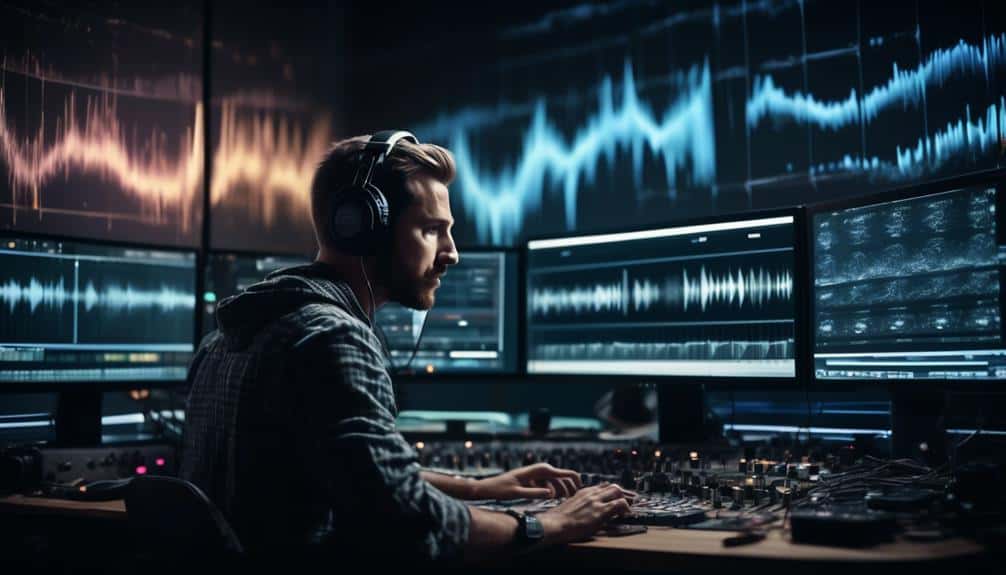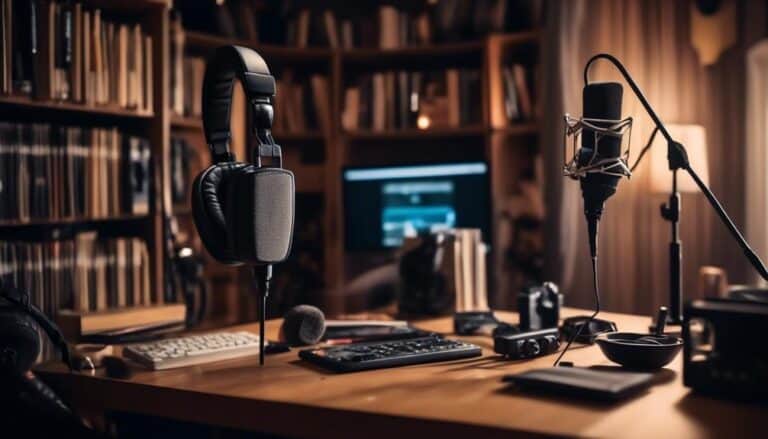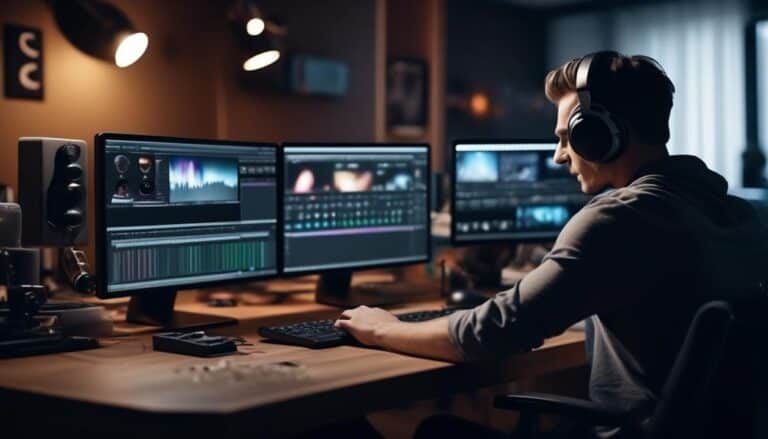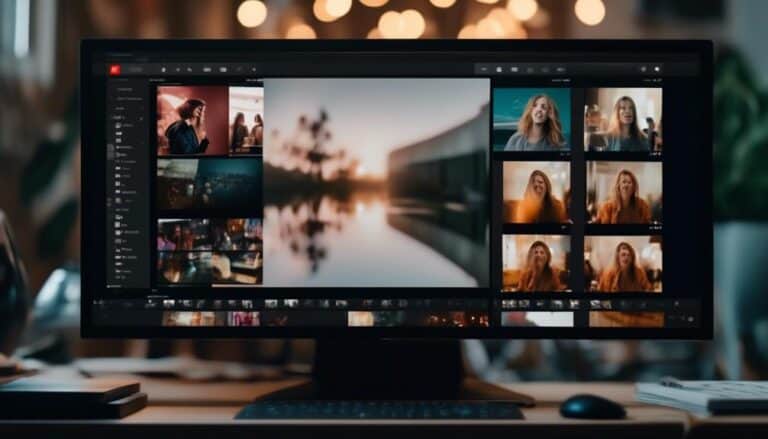Mastering the Mix: Advanced Editing Techniques for Podcasters
In the world of podcasting, finding the right balance between amateur and professional can be a challenging task. You've likely mastered the basics of editing, but now it's time to take your skills to the next level.
Imagine having the ability to seamlessly transition between segments, elevate your sound quality to new heights, and craft a sonic experience that captivates your audience. As a podcaster looking to refine your craft, exploring advanced editing techniques could be the key to unlocking a truly immersive listening experience that sets your content apart from the rest.
Key Takeaways
- Quality digital audio workstations like Adobe Audition or Pro Tools are essential for mastering audio.
- Utilize noise reduction techniques and audio enhancement tools to eliminate unwanted background noise.
- Incorporate ambient sounds, sound effects, music, voice modulation, and silence strategically for enhanced storytelling.
- Align waveforms precisely, adjust fade duration, and experiment with effect combinations to elevate podcast production quality.
Essential Tools for Advanced Editing
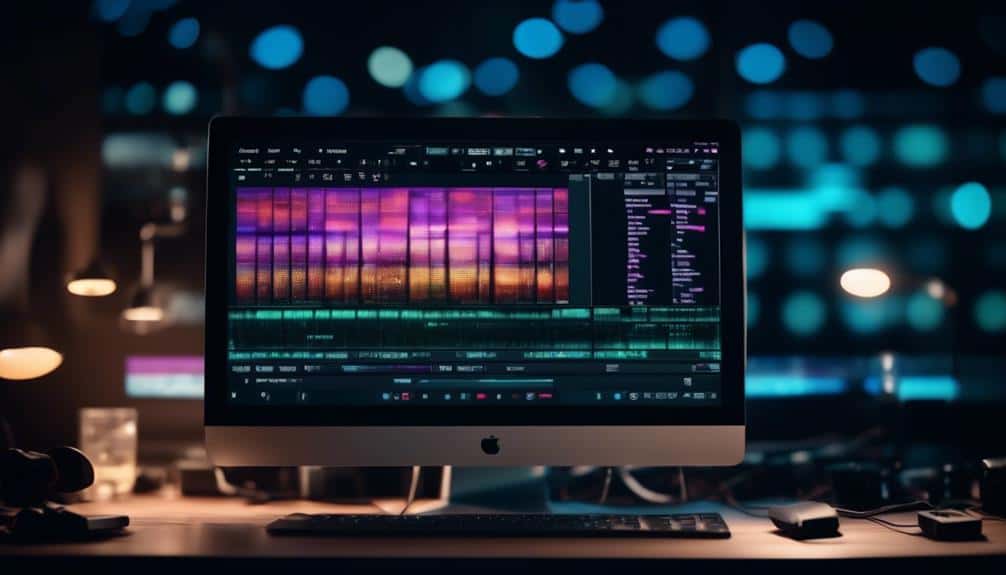
To achieve advanced editing in podcast production, you must equip yourself with essential tools that streamline the post-production process efficiently. When it comes to audio mastering tips and equalization techniques, having a quality digital audio workstation (DAW) is crucial. DAWs like Adobe Audition or Pro Tools offer advanced features for mastering audio and fine-tuning equalization settings to ensure your podcast sounds professional.
For podcast editing hacks and audio processing tricks, plugins play a vital role in enhancing your sound. Invest in plugins like iZotope RX for noise reduction, Waves L2 Ultramaximizer for loudness maximization, and FabFilter Pro-Q 3 for precise equalization adjustments. These tools will help you achieve a polished sound by cleaning up audio imperfections, maximizing volume levels, and shaping the tonal balance of your podcast.
Perfecting Audio Transitions
Utilize precise crossfades to ensure seamless transitions between audio segments in your podcast editing workflow. When perfecting audio transitions, the timing and blending of these transitions are crucial to maintain a professional and engaging podcast.
To achieve this, consider the following:
- Transition timing: Pay attention to the timing of your transitions to maintain a natural flow between segments.
- Audio blending: Ensure that the levels and tones of the audio segments match well during transitions for a smooth listening experience.
- Smooth crossfades: Use crossfades to gradually blend the audio from one segment into another, avoiding abrupt changes that can be jarring to the listener.
- Creative transitions: Experiment with different transition effects and techniques to add an element of creativity and uniqueness to your podcast editing.
Enhancing Sound Quality
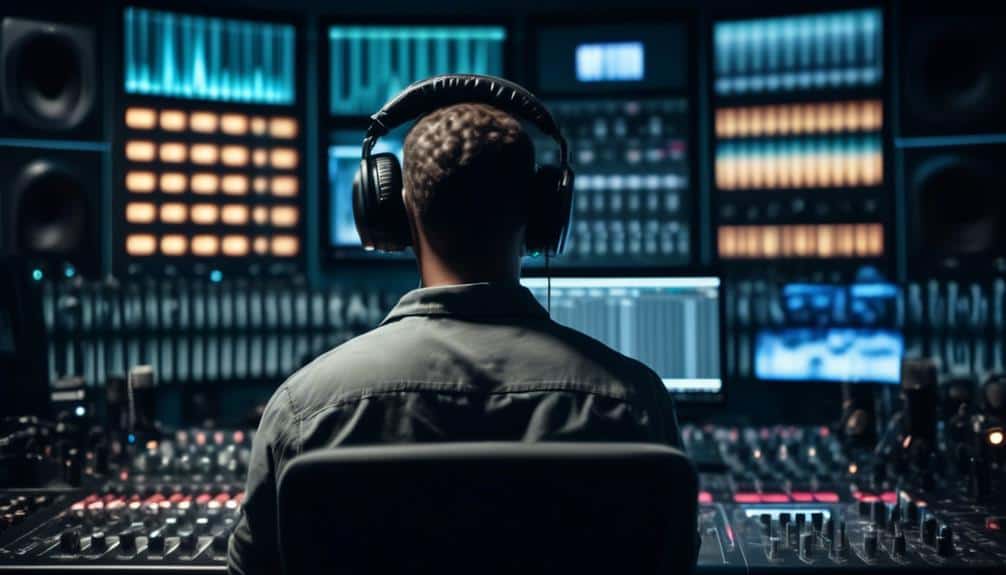
To enhance the sound quality of your podcast, consider utilizing noise reduction techniques and audio enhancement tools. These methods can help you eliminate unwanted background noise, improve clarity, and ensure a professional audio experience for your listeners.
Experiment with different settings and tools to find the best combination that suits your podcasting style.
Noise Reduction Techniques
Consider implementing sophisticated noise reduction algorithms to elevate the audio quality of your podcast recordings. To effectively reduce unwanted noise, focus on these techniques:
- Frequency isolation: Identify and target specific frequencies where noise is prominent.
- Spectral editing: Utilize spectral analysis tools to visualize and manipulate audio frequencies.
- Acoustic environment: Be mindful of the room tone during recording to minimize background noise.
- Room tone: Capture a sample of the silent background in your recording environment to aid in noise reduction post-production.
Audio Enhancement Tools
Enhance the sound quality of your podcast recordings by incorporating advanced audio enhancement tools.
Utilize equalizer settings to fine-tune frequencies, emphasizing vocals and reducing unwanted noise.
Implement compression techniques to regulate audio dynamics, ensuring a consistent volume level throughout your podcast.
Enhance vocals using tools like pitch correction and de-essing to refine the clarity and tone of speech.
Reduce background noise through noise reduction plugins, effectively cleaning up your audio for a professional finish.
By mastering these audio enhancement tools, you can elevate the quality of your podcasts, creating a more engaging listening experience for your audience.
Experiment with these tools to find the perfect balance and enhance the overall sound quality of your podcast recordings.
Advanced Noise Reduction Techniques
Implement advanced noise reduction techniques to enhance the audio quality of your podcasts. By mastering these techniques, you can significantly improve the clarity and professionalism of your recordings. Here are some advanced methods for noise reduction:
- Frequency Isolation: Use advanced EQ tools to target specific frequencies where noise is prominent, allowing you to reduce unwanted sounds without affecting the overall audio quality.
- Spectral Editing: Dive into spectral editing to visualize and manipulate audio frequencies with precision, enabling you to surgically remove noise from your recordings.
- Adaptive Processing: Utilize adaptive processing algorithms to dynamically adjust noise reduction settings based on the audio content, ensuring optimal noise reduction without compromising the natural sound of your podcast.
- Advanced Tools Integration: Integrate specialized noise reduction plugins or software that offer advanced features like machine learning algorithms for more effective noise reduction results.
Implementing Strategic Sound Design
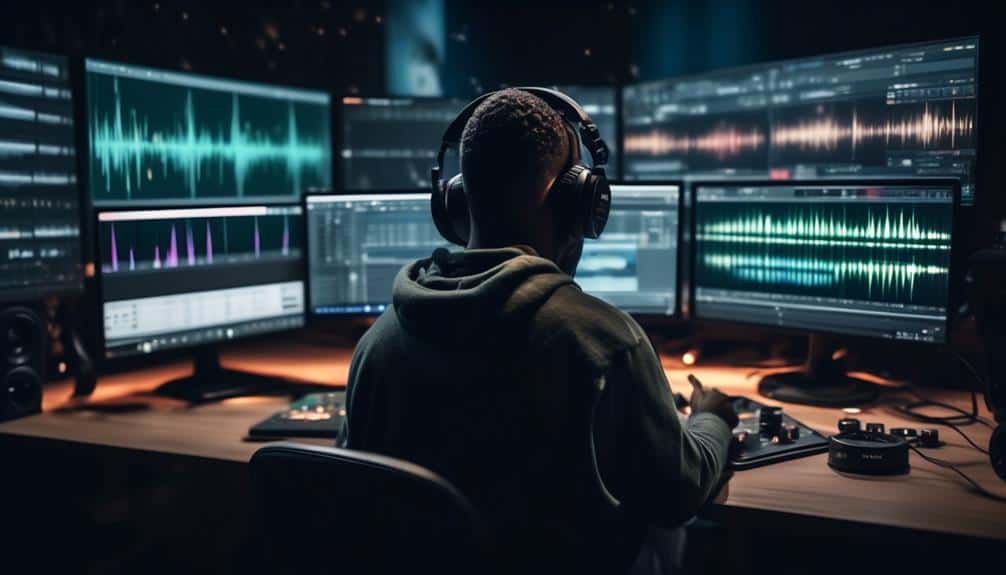
Strategically incorporating sound design elements can elevate the overall auditory experience of your podcasts, enhancing engagement and immersiveness for your listeners. By integrating creative storytelling and focusing on emotional impact, you can create a more compelling listening journey for your audience. Consider the table below to guide you in implementing strategic sound design techniques effectively:
| Sound Design Element | Description | Purpose |
|---|---|---|
| Ambient Sounds | Background noises to set the scene | Enhance realism |
| Sound Effects | Audio cues for emphasis or atmosphere | Create mood and tension |
| Music | Instrumental tracks or themes | Evoke emotions and enhance tone |
| Voice Modulation | Altered vocal elements for characters | Add depth and personality |
| Silence | Absence of sound for dramatic effect | Build tension and highlight moments |
Mastering Multi-Track Editing
To master multi-track editing, you must focus on track blending techniques, ensuring a harmonious combination of different audio elements. Achieve smooth transitions between tracks by employing seamless transition methods, maintaining a cohesive flow of content.
Enhance your podcast's audio quality by incorporating layered audio effects, adding depth and richness to your production.
Track Blending Techniques
Consider blending multiple tracks in your podcast editing process to achieve a seamless and professional final product. When mastering track blending techniques, focus on audio layering techniques and creative mixing to enhance the overall quality of your podcast. To achieve seamless audio blending and track fusion, follow these key steps:
- Layering: Experiment with stacking different audio elements on top of each other for depth and richness.
- Crossfading: Smoothly blend the end of one track with the beginning of another to avoid abrupt transitions.
- EQ Matching: Use equalization to harmonize the frequencies of multiple tracks and create a cohesive sound.
- Panning: Adjust the stereo position of different tracks to create a balanced and immersive listening experience.
Seamless Transition Methods
For achieving seamless transitions in multi-track editing, employ precise crossfading techniques between audio segments to ensure a smooth flow of sound.
To create smooth audio transitions, focus on aligning waveforms precisely and adjusting the fade duration to match the rhythm and pace of your podcast.
Utilize automation tools to fine-tune the volume levels during transitions, ensuring a seamless blend between different tracks.
When making seamless edits, transitions should be virtually undetectable, maintaining the natural flow of the conversation or narrative.
Pay attention to the timing of each transition to prevent abrupt changes that may disrupt the listener's experience.
Layered Audio Effects
In mastering multi-track editing, your focus shifts to enhancing the audio quality through the strategic layering of various effects to elevate the overall production value of your podcast. When it comes to layered audio effects, creative blending and unique layering techniques can truly make your podcast stand out. Here are some tips to help you master this art:
- Experiment with different combinations of effects to create a signature sound.
- Use automation to control the intensity of each layer at different points in your podcast.
- Consider the frequency spectrum of each audio track to ensure that the layers complement each other.
- Don't be afraid to push boundaries and try unconventional effects to add depth and interest to your podcast.
Frequently Asked Questions
How Can Podcasters Effectively Incorporate Music and Sound Effects to Enhance Their Episodes?
To enhance your episodes, effectively integrate music and sound effects. Use audio transitions for smooth flow and layering techniques for depth. Soundscaping creates immersive experiences. Master these elements for a captivating podcast.
Are There Any Specific Techniques for Seamlessly Blending Together Different Audio Tracks in a Podcast?
To seamlessly blend different audio tracks in your podcast, utilize cross fading transitions for smooth shifts and layering techniques to create depth. Experiment with timing and levels to achieve a cohesive and polished sound.
What Are Some Tips for Maintaining Consistent Audio Levels Throughout a Podcast Episode?
To maintain consistent audio levels in your podcast, consider using level automation for precise control. Implement compression techniques to even out loud and soft parts. Equalization can enhance clarity, while limiting strategies prevent peaks.
How Can Podcasters Effectively Remove Background Noise and Distractions From Their Recordings?
To effectively remove distractions and background noise in your recordings, utilize noise reduction techniques. Identify problematic areas, apply filters, adjust thresholds, and utilize tools like spectral editing to isolate and eliminate unwanted sounds, ensuring a clean and professional podcast.
What Are Some Creative Ways to Use Advanced Editing Techniques to Tell a Compelling Story in a Podcast Episode?
To enhance character development in your podcast, use advanced editing techniques such as layering multiple voices to create depth and nuance. Building suspense can be achieved by strategically placing pauses and manipulating audio dynamics for dramatic effect.
Conclusion
In conclusion, mastering advanced editing techniques for podcasting requires a combination of essential tools. Perfecting audio transitions and enhancing sound quality are crucial aspects. Advanced noise reduction techniques and strategic sound design play a significant role. Additionally, mastering multi-track editing is essential for a polished final product.
By implementing these techniques with precision and attention to detail, podcasters can elevate the production quality of their episodes and create a more immersive listening experience for their audience.
Keep refining your skills and experimenting with different editing methods to continue improving your podcasting craft.
